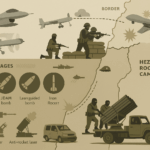Prime Minister Mark Carney has broken from decades of caution. He pledged an extra US $6.6 billion (CA $9 billion) for the Department of National Defense in the current fiscal year, moving Canada to the NATO 2 percent-of-GDP benchmark by April 2026 and signalling the start of a long-term shift toward European partnerships. Canada’s move aligns with evolving NATO defense spending targets across the alliance.
The announcement came after warnings from allies and economists that Canada’s reliance on U.S. equipment leaves vulnerabilities. Carney told reporters that Washington’s new tariffs and talk of “monetising hegemony” make diversification urgent. Defense officials confirm the cabinet agreed that Ottawa must “look two ways across the Atlantic, not one way over the 49th parallel.”
Canada Defense Spending Surges to Meet NATO 2% GDP Commitment
New money lifts total defense and security spending to about US $45.7 billion (CA $62.7 billion) this year. Our analysis shows the annual figure is expected to climb again in 2026-27 if equipment timelines hold and inflation remains above two percent.
According to industry sources, CA $4.1 billion of the extra cash is ring-fenced for domestic firms that promise lower U.S. content, faster delivery, and clearer technology transfer. Procurement staff have been told that foreign bids must now show credible co-production or licensed manufacture in Canada.
Canada’s Military Budget Prioritizes European Equipment and Industrial Development
Defense officials confirm the industrial push rests on four near-term pillars:
- Direct capital grants for factories that switch to European-spec components.
- A streamlined export-control regime for licensed Canadian variants of European designs.
- Priority access to the federal “critical minerals corridor” to shorten supply chains.
- A skills program that subsidises advanced welding, composites, and cyber-security courses for defense workers.
The Canadian Army gains first. This focus aligns with recent European defense spending commitments that prioritize modernization and interoperability. A contract for a ground-based air-defence battery will be let before year-end, with Saab’s RBS 70 NG listed as the baseline system. A bigger project follows in 2026 for layered counter-drone, counter-rocket, and counter-mortar coverage. Self-propelled howitzers are next on the docket after a decade-long capability gap.
Expected land procurements include:
- 120 RBS 70 NG launchers for the rapid-deploy battle group in Latvia.
- 42 tracked 155 mm howitzers with precision-guided munitions.
- 1,500 logistics utility vehicles built in Canada under licence from a European OEM.
- Electronic-warfare suites for two light infantry brigades.
At sea, the Canadian Patrol Submarine Project receives political cover and fresh cash. Cabinet authorised negotiations for up to 12 conventionally powered submarines able to operate under ice. Shortlisted designs come from:
- South Korea’s KSS-III Batch II.
- Sweden’s A26 Polar.
- Germany’s Type 212CD.
Officials state the request for proposals will seek first steel cut in 2028 and first delivery by 2035, preventing a capability gap when Victoria-class boats retire.
Heavy icebreakers also get priority. The Coast Guard will order at least three hulls, each with a 45-day endurance north of 70° latitude. Shipyards in British Columbia and Quebec will share the work to spread risk and jobs.
Air-force modernization enters a holding pattern. Carney froze the F-35 order after the first 16 jets, pending a summer review that looks at European fighters assembled in Canada. The study teams have asked for industrial data from France’s Rafale, Britain-Italy’s Tempest programme, and a notional “Gripen CAX” variant with Canadian mission systems.
Future air projects under review include:
- Five domestically built early-warning and control aircraft based on a European platform.
- A medium-altitude drone squadron for Arctic signals collection.
- Expansion of the Aurora maritime-patrol fleet through life-extension kits.
- A joint training hub for sixth-generation fighter tactics with European partners.
People programmes rank high. Regular-force pay rises eight percent this year; reservists get a new tax-free stipend for weekend training. Cyber operators move to a unified command with CA $560 million earmarked for secure cloud and quantum-safe encryption. The plan also finances a fresh rotation of Over-the-Horizon Radar sites and ground stations for the next NORAD satellite layer.
Cross-domain enablers receive:
- CA $1 billion for Arctic over-the-horizon radar and data-fusion nodes.
- CA $700 million for domestic ammunition production lines.
- CA $400 million to expand the Joint Counter-Drone Program.
- CA $350 million for quantum-enhanced navigation and timing research.
Carney ruled out tax rises, pointing instead to trimmed departmental overheads and a sovereign-defense bond that targets pension funds. Our analysis shows the bond could raise CA $5 billion over three years if priced at a 40-basis-point premium to ten-year treasuries.
Canada and NATO Strengthen Ties through Equipment Procurement and Joint Programs
Bridges to Europe extend beyond equipment. Ottawa will join the EU’s ReArm Europe scheme next month, giving Canadian firms entry to joint procurement lots for artillery shells, secure radio chips, and cross-domain cloud services. According to industry sources, a staff-level accord already pairs Canadian critical-minerals producers with European battery makers in return for priority access to NATO innovation challenge funds.
NATO officials welcomed the move, noting that earlier burdensharing disputes had strained alliance unity. Berlin signalled interest in co-developing an ice-capable drone with Canadian avionics. Paris offered surplus Rafales for interim air-defense coverage if the F-35 review drags on.
Our analysis shows three hurdles could slow progress:
- A procurement bureaucracy that still averages 16 months from request to contract.
- Limited test ranges for advanced electronic-warfare systems inside Canada.
- Fragmented sustainment budgets that complicate through-life support for mixed fleets.
Defense officials confirm a joint Treasury-DND task force will propose fixes by year-end.Canada’s defense rethink now rests on execution. Success would give the Canadian Armed Forces modern tools, cut exposure to U.S. policy swings, and embed industry on both sides of the Atlantic. Failure would strand critical projects in mid-stream and raise costs for every partner involved. The next twelve months will reveal whether Ottawa can turn bold intent into real capability and lasting bridges to Europe.
REFERENCE SOURCES
- https://www.navalnews.com/event-news/madex-2025/2025/05/madex-2025-hanwha-ocean-eyes-canadas-submarine-requirement/
- https://www.flightglobal.com/defence/canada-will-increase-defence-spending-to-reach-nato-target-this-year/163281.article
- https://www.canada.ca/content/dam/dnd-mdn/documents/corporate/reports-publications/2024/north-strong-free-2024-v2.pdf
- https://www.defensenews.com/global/the-americas/2025/05/16/canada-faces-dense-defense-acquisition-docket-as-f-35-review-looms/
- https://gowlingwlg.com/en/insights-resources/articles/2024/a-renewed-vision-for-canada-s-defence
- https://www.cbc.ca/news/politics/f35-blair-trump-1.7484477
- https://www.canada.ca/en/department-national-defence/news/2025/06/canadas-new-government-is-rebuilding-rearming-and-reinvesting-in-the-canadian-armed-forces.html
- https://pism.pl/publications/canada-updates-its-national-defence-strategy-consequences-for-nato
- https://www.cigionline.org/static/documents/Canadas_Arctic-_A_Strategic_Blueprint_for_Resilient_Sovereignty_0FYTxwa.pdf
- https://www.reuters.com/business/aerospace-defense/canada-promises-ramp-up-defense-spending-met-nato-target-much-earlier-2025-06-09/
- https://www.pm.gc.ca/en/news/news-releases/2025/06/09/canadas-new-government-rebuilding-rearming-and-reinvesting-canadian
- https://defensescoop.com/2025/06/09/canada-new-military-spending-plan-mark-carney/
- https://www.politico.com/news/2025/06/09/carney-canada-nato-defense-spending-target-00394341


